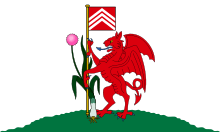Iestyn ap Gwrgant
| Iestyn ap Gwrgant King of Morgannwg | |
|---|---|
|
Armorial Bearings of Gwrgant | |
| Reign | 1081-1093 |
| Coronation | 1081 |
| Predecessor | Caradog ap Gruffydd |
| Hereditary | Extinct |
| Born |
1014 Morgannwg, Wales |
| Died |
1093 Llangenyw, Denbighshire, Wales |
| Consort | Constance verch Cadwgon |
| Wife |
|
| Issue |
Catrin verch Iestyn Madog ap Iestyn Caradog ap Iestyn Rhys ap Iestyn Nest verch Iestyn Gwenllian verch Iestyn |
| Welsh | Brythonic Branch |
| House | Morgannwg |
| Father | Gwrgant ab Ithel |
| Mother | MissVerch Gwerystan |
Iestyn ap Gwrgant [ˈjɛstɪn ap ˈgʊrgant] (or Jestyn ap Gwrgant) (English: Justin, son of Gwrgant) (c. 1045 – 1093) was the last ruler of the Welsh kingdom of Morgannwg, which encompassed the counties of Glamorgan and Monmouthshire.[1][2]
Lineage
Iestyn ap Gwrgant was the last ruler of the royal house of Morgannwg, which had a lineage stretching back over five centuries to Tewdrig (c. 550–584). The members of this royal house had links to the other royal houses of Wales through marriage, and were descendants of the celebrated Rhodri Mawr. Iestyn ap Gwrgant's base is believed to have been at Dinas Powis, south west of Cardiff.
Norman invasion
Iestyn probably ruled Morgannwg for a little less than a decade (c. 1081–1090) and is believed to have built castles in the regions of Cardiff and Kenfig. The popular version of historical events is that Iestyn, following a dispute with his rival Einion ap Collwyn, invited Robert Fitzhamon and his twelve knights into the region to settle the matter. Naturally, once invited in, they refused to leave. He was deposed c. 1090 by Norman ruler Robert Fitzhamon, lord of Gloucester, who established a lordship based in Cardiff and subsequently conquered the lowlands of Glamorgan (the Vale of Glamorgan), which was parcelled out to his followers. The mountainous parts of Glamorgan were left in Welsh control. Caradog ap Iestyn, the eldest son of Iestyn ap Gwrgant, was the only Welsh lord to retain lands in the Glamorgan lowlands after Fitzhamon had conquered them. He retained the land between the River Neath and the River Afan, and he and his descendants were known as the "lords of Afan." His descendants are thought to include the Williams family of Aberpergwm.
Modern interpretation

Iestyn ap Gwrgant's arms can be seen today in a modern context as a banner of the arms forms the Flag of Glamorgan which itself forms a charge on the flag of Cardiff. Additionally the arms are found within the crest of Pontypridd Rugby Football Club, a Rugby Union team from Pontypridd within the ancient boundaries of Morgannwg.[3] Richard Williams Morgan claimed that a reference to a son of Caratacus called Saint Cyllin was found in the family records of Iestyn ab Gwrgant and used this as evidence of early entry of Christianity to Britain "Cyllin ab Caradog, a wise and just king. In his days many of the Cymry embraced the faith in Christ through the teaching of the saints of Cor-Eurgain, and many godly men from the countries of Greece and Rome were in Cambria. He first of the Cymry gave infants names; for before, names were not given except to adults, and then from something characteristic in their bodies, minds, or manners."[4]
References
- ↑ 'The winning of Glamorgan: Introduction', Cardiff Records: volume 4 (1903), pp. 1–5. Date accessed: 08 August 2012
- ↑ Anonymous (31 March 2004). The Genealogy Of Iestyn The Son Of Gwrgan. Kessinger Publishing. pp. 539–. ISBN 978-0-7661-8411-4. Retrieved 8 August 2012.
- ↑ http://www.ponty.net/a-quick-guide
- ↑ Richard Williams Morgan (1861). St. Paul in Britain; or, The origin of British as opposed to papal Christianity. pp. 161–. Retrieved 8 August 2012.
External links
 "Iestin ab Gwrgant". Dictionary of National Biography. London: Smith, Elder & Co. 1885–1900.
"Iestin ab Gwrgant". Dictionary of National Biography. London: Smith, Elder & Co. 1885–1900. - National Library of Wales Dictionary of Welsh Biography
| Regnal titles | ||
|---|---|---|
| Preceded by Caradog ap Gruffydd |
King of Morgannwg 1081 – c. 1090 |
Succeeded by Abolished |
